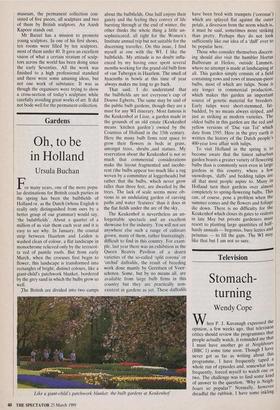Gardens
Oh, to be in Holland
Ursula Buchan
or many years, one of the more popu- lar destinations for British coach parties in the spring has been the bulbfields of Holland or, as the Dutch (whose English is really only distinguished from ours by a better grasp of our grammar) would say, 'the bulubfields'. About a quarter of a million of us visit them each year and it is easy to see why. In January, the coastal strip between Haarlem and Leiden is washed clean of colour, a flat landscape in monochrome relieved only by the terracot- ta red of pantile roofs. But from early March, when the crocuses first begin to flower, this landscape is transformed into rectangles of bright, distinct colours, like a giant-child's patchwork blanket, bordered by the grey sand in which the bulbs grow so well.
;The British are divided into two camps about the bulbfields. One half enjoys their gaiety and the feeling they convey of life bursting through at the end of winter, the other thinks the whole thing a little un- sophisticated, all right for the Women's Institute annual trip but not suitable for the discerning traveller. On this issue, I find myself at one with the WI. I like the bulbfields. My attitude is no doubt influ- enced by my having once spent several months working for the grand old bulb firm of van Tubergen in Haarlem. The smell of hyacinths in bowls at this time of year always makes me long to go back.
That said, I do understand that the bulbfields are not everyone's cup of Douwe Egberts. The same may be said of the public bulb gardens, though they are a must for any WI itinerary. Most famous is the Keukenhof at Lisse, a garden made in the grounds of an old estate (Keukenhof means 'kitchen garden') owned by the Countess of Holland in the 15th century. Here the many bulb firms rent space to grow their flowers in beds in grass, amongst trees, shrubs ,and statues. My reservation about the Keukenhof is not so much that commercial considerations make the layout fragmented and incohe- rent (the bulbs appear too much like a rug woven by a committee at loggerheads) but rather that the bulbs, which never grow taller than three feet, are dwarfed by the trees. The lack of scale seems more ob- vious in an undulating garden of curving paths and water 'features' than it does in the flat fields under the arc of the sky.
The Keukenhof is nevertheless an un- forgettable spectacle and an excellent showcase for the industry. You will not see anywhere else such a range of cultivars grown, many of them, rather frustratingly, difficult to find in this country. For exam- ple, last year there was an exhibition in the Queen Beatrix Pavilion of a dozen varieties of the so-called 'split corona' or 'orchid' daffodils, the result of breeding work done mainly by Gerritsen of Voor- schoten. Some, but by no means all, are available from large bulb firms in this country but they are practically non- existent in gardens as yet. These daffodils Like a giant-child's patchwork blanket: the bulb gardens at Keukenhof have been bred with trumpets ('coronas') which are splayed flat against the outer petals, a diversion from the norm which is, it must be said, sometimes more striking than pretty. Perhaps they do not look sufficiently like our idea of a 'daft' ever to be popular here.
Those who consider themselves discern- ing should also visit the humbler Hortus Bulborum at Heiloo, outside Limmen, where no attempt is made at landscaping at all. This garden simply consists of a field containing rows and rows of museum-piece bulbs, most of which are tulips. None is any longer in commercial production, which makes this garden an important source of genetic material for breeders. Early tulips were short-stemmed, fat- budded, by no means always striped, and just as striking as modern varieties. The oldest bulbs in this garden are the red and yellow versions of 'Due van Tol' which date from 1595. Here in the grey earth is written the history of the Dutch people's 400-year love affair with tulips. To visit Holland in the spring is to become aware that the tiniest suburban garden boasts a greater variety of flowering bulbs than is commonly seen even in large gardens in this country, where a few snowdrops, 'claffs' and bedding tulips are all that most people aspire to. Many In Holland turn their gardens over almost completely to spring-flowering bulbs. This can, of course, pose a problem when the summer comes and the flowers and foliage die down. There is no difficulty for the Keukenhof which closes its gates to visitors in late May but private gardeners must resort to planting large quantities of half- hardy annuals — begonias, busy lizzies and petunias — to fill the gaps. The WI may like that but I am not so sure.


















































 Previous page
Previous page